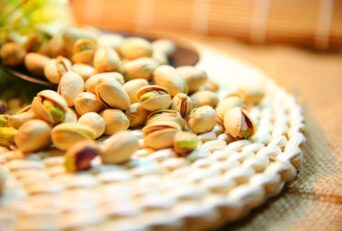Camellia oil is a rich source of Omega-6 fatty acids and anti-aging polyphenol antioxidants apart from essential vitamins and minerals.
Furthermore, Camellia oil possesses a unique active constituent called Squalene, also an important side product of the skin’s natural emollient system, deficiency of which leads to the formation of dry skin and premature aging, wrinkles, and sagginess in the skin.
Camellia oil, frequently referred to as Tea oil camellia or oil seed camellia, is an edible, pale amber-green fixed oil having a sweet, herbal aroma, cold pressed mainly from the seeds of Camellia sinensis.
Also, a common misconception is the association of the tea seed oil with Camellia oil where the latter is pressed from the seeds of Camellia japonica also called Tsubaki oil.
Camellia oil is procured from the seeds of tea trees which are full in Vitamins A, B, C & E and other important minerals like Potassium, Zinc, Calcium, Iron, Manganese and Magnesium.
Japanese camellia oil is best utilized when obtained by cold pressing seeds of the Camellia japonica flower (known as Tsubaki in Japanese). Camellia oil is often referred to as the ‘olive oil of Asia.’
Camellia oil has outstanding moisture retaining the ability and has excellent absorptivity if compared to other natural plant oils. This unique feature of this oil allows it to penetrate into the deepest layers of the skin making it smoother and supple.
This non-clogging oil is a rich source of monosaturated essential fatty acids particularly high in Oleic acids exceeding the level of olive oil.
Being a healthy, natural oil, your next question must be the composition or the content of vitamins and minerals in this healthy oil, right?
Table of Contents
Health Benefits Of Camellia Oil
Health benefits of Camellia oil are said to be beneficial for people suffering from gastroesophageal reflux, ulcers, and heartburns. The oil has also been utilized on skin wounds to aid in healing and to keep infection at bay.
Among other health benefits, it is also a transdermal carrier of cell rebuilding nutrients and compounds like collagen and elastin which repair damage caused due to exposure to the sun.
Biosafety Research Center For Foods, Drugs, and Pesticides in Japan and studies conducted at National Chung Hsing University support the supplements of Camellia oil and its associated benefits.
1. Vitamin E & Sunblock Properties
Although there have been numerous claims of the content of Vitamin E in Camellia oil, they are misleading. Vitamin E is mainly of 2 forms- firstly Tocotrienols, the so-called “ super Vitamin E” and secondly Tocopherols, the so-called “much less effective Vitamin E.”
Though Camellia oil contains only low to moderate levels of Tocopherol Vitamin E (60mg/1000gms), it does not contain a substantial level of Tocotrienol, for which Rice bran oil is a far better substitute at 600-800 mg/1000gms.
Common exaggerated claims suggest Camellia oil having significant sunblock properties, although all vegetable based oils have a low SPF (about 3-5) and should be avoided as a primary sunblock cream.
So, how should you use this oil to gain maximum benefits from it?
Several studies suggest Camellia oil in combination with rice bran oil to take advantage of their benefits. But don’t you think mixing the two oils will only utilize half of the benefits of each oil?
Alternatively, since both are absorbed rapidly by the skin, one can be applied about 15 minutes after applying the other.
2. Body Nourishment
Camellia oil is a nutrient-rich and antioxidant-rich skin emollient and moisturizer. Its fatty acids contain potent agents for retention and enhancement of your skin moisture. Due to its fast absorbing and penetration property into the lower layers of the skin, it:
- Moisturizes and nourishes skin
- Restores the elasticity of your skin
- Helps to diminish the fine lines and wrinkles
- Repairs stretch marks commonly after pregnancy
- Heals minor acne scars and blemishes.
- Japanese Camellia oil serves an excellent job to soften your rough skin in areas such as knees, elbows, heels, etc.
3. Nails And Cuticle Care
After showering, add 1 or 2 drops to a cotton pad and wipe your nails and cuticles. It helps soften your dry or brittle nails and rough cuticles. It also helps in keeping the nails nourished, smooth and shiny. Moreover, it helps in alleviating discomfort from the dry skin under. For complete care of the nail, you can use different cuticle oil.
How To Use?
Mix about a ½ teaspoon of seaweed powder with three tablespoons of hot water and apply slowly onto hair and scalp. Rinse well and apply Camellia oil.
4.For Skincare & Facial
You must have watched Japanese female entertainers in TV’s acting as hostesses performing various arts like classical music, dance, and games. They are known as Geishas.
Camellia oil is referred to as the beauty secret of the Geishas.One of the fascinating things that you will come across is that the beauty creams that are available in the markets are 50% water based, so oils are more effective.
Your skin feels, understands and absorbs oils more profoundly since the skin is naturally oily. In other words, it speaks and understands the same oily language. You must be curious about how oil works effectively on oily skin.
The oils that you add to the skin penetrates the pores to clean them better rather than clogging them more.Camellia oil acts as an excellent emollient and a moisturizer and has a silky, creamy texture. It helps to restore PH balance and has a buffering quality shielding the skin from external environmental pollutants.
For men, Camellia oil soothes the skin after shaving and keeps the skin well conditioned and aids in preventing shaving burns.
How To Use It On Your Skin?
- Lay a small amount of oil onto your palm.
- Rub your palms spreading the oil into thin layers.
- Pat the oil over your face and neck by gently
- Spread the oil in a circular motion until it is completely absorbed.
- For areas contained with wrinkles and blemishes, add a small drop to your fingertips and directly apply to the affected areas.
If going for natural remedies try, doing facials at home.
5.For Hair
The Belgravia Centre for Statistics shows 40% of men have noticeable hair loss by age 35, 65% by age 60 and 80% by age 80 due to dry, itchy scalp and improper nourishment.Camellia oil is again there for your rescue.
Camellia oil has a golden color and creamy in texture responsible for the classic, legendary beauty of Japanese hair. In Japan, Camellia oil is used as a leave-in, utilized best when applied after showering on damp hair. The quantity of application is a matter of your personal preference. Geishas, to make their hair glossy, apply a lot of oil.
It can also be applied before washing to untangle hair and give it a manageable look.
Some of the benefits of this oil include the following:
- Makes the hair soft and manageable
- Helps in restoring the hair’s natural shine
- Helps in retaining the hair moisture
- Acts as a potential barrier against environmental pollutants
- Repairs rough and split ends
- Aides in the dry and itchy scalp
- Helps in preventing dandruff from returning
How To Use It On Your Hair?
If you want to gain maximum benefits, try applying it to your hair after washing by following the simple steps: Dry your hair after washing and apply few drops of Camellia oil onto your palms and spread it well. Starting from the top, apply it to your hair and scalp by gently massaging through fingertips.
a. Use As Deep Treatment Pack
Camellia oil helps in restoring brilliance to dull hair and damage treatment from heat, perms, and coloring if used as a deep hair treatment pack.
Apply few drops of oil to your hair before washing by covering with a shower cap and wrapping with a towel to keep it warm for 20- 30 minutes. Now, shampoo and rinse well.
b. Use With Seaweed Hair Cleanser
Japanese camellia oil can also be used as a conditioner after washing your hair with seaweed. Seaweed hair cleanser is often mixed with water as powdered seaweed to produce a gel-like a mixture which can be used as a deep treatment pack or mixed with shampoo.
You can also go for natural hair cleansers for strong healthy, shiny and strong hair.
Camellia & Its Varieties
The Camellia family of plants have a large number of species. Some of them are Camellia Japonica (Tsubaki), Camellia Sinensis, Camellia Oleifera. Although they are referred to as “Camellia,” but they have significant differences in their properties and origin.
Camellias Japonica, Sinensis, And Olivera Differences
Japonica also called ‘Tsubaki’ which is a native to southern Japan. The most common variety known as Yabu Tsubaki are dark pink to red in color and texture with 5-7 petals in the shape of a cup from the bottom.
They have a distinct waxy coating on the upper side of the leaves which give a shiny, waxy coating in the light. This tree blooms in winter early spring, and its seeds are harvested in fall.
Camellia sinensis produce all teas including green, black, Pu-erh and Oolong also called as Tea Oil.
Camellia Olivera is a notable source of edible oils and very much similar to olive oil in composition with about 72% Oleic acid, commonly referred to as oil seed camellia.
Why Are Unrefined Oils Better For You?
Unrefined oils are the one which is not subjected to high heat or chemicals and maintains the oil’s original character for controlling color and scent. Refining uses a combination of chemical, filtration or heat processing to control color and scent of oil.
Once refined, oils lose important nutrients and antioxidants in the process which are less expensive to produce, since the final product looks and feel the same, regardless of different grade oils being used.






